What is in this leaflet
This leaflet answers some common questions about EPIDYOLEX. It does not contain all the available information. It does not take the place of talking to your doctor or pharmacist.
All medicines have risks and benefits. Your doctor has weighed the risks of you taking EPIDYOLEX against the benefits they expect it will have for you.
If you have any concerns about taking this medicine, ask your doctor or pharmacist.
Keep this leaflet with the medicine. You may need to read it again.
What EPIDYOLEX is used for
EPIDYOLEX contains cannabidiol, a medicine which can be used to treat epilepsy, a condition where someone has seizures or fits.
EPIDYOLEX is used in combination with other antiepileptic medicines to treat seizures that occur with two rare conditions, called Dravet syndrome and Lennox-Gastaut syndrome. It can be used in adults, adolescents, and children of at least 2 years of age.
Ask your doctor if you have any questions about why this medicine has been prescribed for you.
Your doctor may have prescribed it for another reason.
This medicine is available only with a doctor's prescription.
Before you take EPIDYOLEX
When you must not take it
Do not take EPIDYOLEX if you have an allergy to:
- any medicine containing cannabidiol
- any of the ingredients listed at the end of this leaflet.
Some of the symptoms of an allergic reaction may include:
- shortness of breath
- wheezing or difficulty breathing
- swelling of the face, lips, tongue, or other parts of the body
- rash, itching or hives on the skin.
Do not take EPIDYOLEX if your doctor tells you that you have abnormal liver blood tests.
Do not give this medicine to a child under the age of 2 years. Safety and effectiveness in children younger than 2 years have not been established.
Do not take this medicine after the expiry date printed on the pack or if the packaging is torn or shows signs of tampering. If the medicine has expired or is damaged, return it to your pharmacist for disposal.
If you are not sure whether you should start taking this medicine, talk to your doctor.
Before you start to take it
Tell your doctor if you have allergies to any other medicines, foods, preservatives, or dyes.
Tell your doctor if you have or have had liver problems. Your doctor may need to change the dose of EPIDYOLEX or may decide that EPIDYOLEX is not appropriate for you. Your doctor may do blood tests to check your liver before you start taking this medicine and during treatment, as EPIDYOLEX can cause liver problems (see also the “While you are using EPIDYOLEX” section).
Tell your doctor if you are pregnant or plan to become pregnant or are breast-feeding.
Your doctor can discuss with you the risks and benefits involved.
You should not take EPIDYOLEX while you are pregnant unless your doctor decides the benefits outweigh the potential risks.
You should not breast-feed whilst taking EPIDYOLEX, as the active ingredient may pass into breast milk.
EPIDYOLEX contains sesame oil, ethanol (alcohol) and strawberry flavour components. Sesame oil may cause rare severe allergic reactions in some people.
Each mL of EPIDYOLEX contains 79 mg of ethanol, equivalent to 10% by volume ethanol (alcohol), i.e., up to 553.04 mg per maximal single EPIDYOLEX dose (for an adult weighing 70 kg), equivalent to 14 millilitres (mL) of beer, or 6 mL of wine per dose.
If you have not told your doctor about any of the above, tell him/her before you start taking EPIDYOLEX.
Taking other medicines
Tell your doctor or pharmacist if you are taking any other medicines, including any that you get without a prescription from your pharmacy, supermarket, or health food shop. Taking EPIDYOLEX with some medicines may cause side effects, affect how the other medicines work, or affect how EPIDYOLEX works. Do not start or stop other medicines without talking to your doctor or pharmacist.
Tell your doctor if you are taking any of the following medicines, as your dose may need to be adjusted:
- other epilepsy medicines used to treat seizures such as carbamazepine, clobazam, lamotrigine, lorazepam, phenytoin, stiripentol, and valproate
- medicines used to suppress the immune response such as everolimus, tacrolimus, sirolimus and ciclosporin
- digoxin, a medicine used to treat irregular heart rhythms
- medicines used to treat acid reflux (heartburn or acid regurgitation) such as omeprazole
- mitotane, a medicine used to treat tumours in the adrenal gland
- medicines used to treat pain such as morphine or diflunisal
- efavirenz, a medicine used to treat HIV/AIDS
- theophylline, a medicine used to treat asthma
- caffeine, a medicine for babies who need help breathing
- propofol, an anaesthetic used for people undergoing surgery
- medicines used to treat high cholesterol such as fenofibrate and gemfibrozil
- enzalutamide, a medicine to treat prostate cancer
- bupropion, a medicine to help stop smoking or for treating obesity
- St. John’s wort (Hypericum perforatum), an herbal medicine used to treat mild anxiety
- rifampin, a medication to treat bacterial infection.
How to take EPIDYOLEX
Follow all directions given to you by your doctor or pharmacist carefully. They may differ from the information contained in this leaflet.
If you do not understand the instructions, ask your doctor or pharmacist for help.
How much to take
EPIDYOLEX is an oral solution (a liquid to be swallowed). Your doctor and pharmacist will tell you how much (number of millilitres) EPIDYOLEX to take each day, how many times a day you should take it, and which syringe you should use for your dose (1 mL or 5 mL).
Your doctor will calculate the dose according to your body weight. You may start on a low dose that your doctor gradually increases over time.
Contact your doctor if you are unsure of your dose or if you think your dose may need to be changed.
Your doctor may need to adjust the dose if you have liver problems.
How to take it
See the “Instructions For Use” section at the end of this leaflet.
When to take it
Taking EPIDYOLEX with food can increase the amount of medicine your body takes in. You should try, as far as possible, to take this medicine consistently either with or without food, including high-fat meals (such as ketogenic diet), and according to your daily routine, so you get the same effect each time. If you take EPIDYOLEX with food, a similar meal type (e.g. similar fat content) should be taken if possible.
How long to take it
Continue taking your medicine for as long as your doctor tells you.
This medicine helps to control your condition but does not cure it. It is important to keep taking your medicine even if you feel well.
Do not reduce the dose or stop this medicine unless the doctor tells you to.
If you forget to take it
If you forget to take a dose, do not take the dose when you remember or double dose to make up for a forgotten dose. Take the next dose at your regular time. If you miss many doses, please talk to your doctor about the correct dose to take.
If you take too much (overdose)
Immediately telephone your doctor or the Poisons Information Centre (telephone 13 11 26 in Australia or 0800 POISON or 0800 764766 in New Zealand) for advice, or go to Accident and Emergency at the nearest hospital, if you think that you or anyone else may have taken too much EPIDYOLEX.
Do this even if there are no signs of discomfort or poisoning. You may need urgent medical attention.
Signs of taking more EPIDYOLEX than you should include diarrhoea and sleepiness.
While you are using EPIDYOLEX
Things you must do
If you are about to be started on any new medicine, remind your doctor and pharmacist that you are taking EPIDYOLEX.
Tell any other doctors, dentists, and pharmacists who treat you that you are taking this medicine.
If you are going to have surgery, tell the surgeon or anaesthetist that you are taking this medicine.
If you become pregnant while taking this medicine, tell your doctor immediately.
Keep all of your doctor's appointments so that your progress can be checked.
Your doctor may do some tests (such as liver function tests) from time to time to make sure the medicine is working and to prevent unwanted side effects. If your liver is not working properly, your treatment may need to be stopped.
Talk to your doctor between visits as needed, especially if you are worried about symptoms.
Things you must not do
Do not take EPIDYOLEX to treat any other complaints unless your doctor tells you to.
Do not give your medicine to anyone else, even if they have the same condition as you.
Do not lower the dose or stop taking EPIDYOLEX without first talking to your doctor.
Stopping a seizure medicine such as EPIDYOLEX suddenly can cause you to have seizures more often or seizures that do not stop (status epilepticus).
If possible, your doctor will gradually reduce the amount you take each day before stopping the medicine completely.
Things to be careful of
Contact your doctor or go to a hospital straight away if:
- your seizures happen more often, or if you experience a severe seizure while taking EPIDYOLEX
- you notice unusual changes in your mood or behaviour or have thoughts of harming or killing yourself.
Do not drive, operate machinery, or take part in activities that require you to be alert and have fine control, such as cycling, until you are certain how EPIDYOLEX affects you.
This medicine may cause sleepiness in some people. If you have any of these symptoms, do not drive, operate machinery or do anything else that could be dangerous. Children should be careful when riding bicycles or climbing trees.
EPIDYOLEX is a cannabis-based medicine and you should also consider any local state laws concerning driving.
Side effects
Tell your doctor or pharmacist as soon as possible if you do not feel well while you are taking EPIDYOLEX.
Like all medicines, this medicine can cause side effects, although not everybody gets them.
Do not be alarmed by the following lists of side effects. You may not experience any of them.
Tell your doctor or pharmacist if you notice any of the following and they worry you:
- feeling drowsy or sleepy
- decreased appetite
- diarrhoea
- fever
- feeling tired
- vomiting
- lack of energy
- cold, sore throat
- respiratory tract infections (pneumonia, bronchitis)
- blood tests showing increases in levels of certain liver enzymes (which may be signs of liver damage)
- shaking of the body or parts of it
- feeling bad-tempered (irritable, aggressive)
- difficulty in sleeping
- cough
- rash
- increased appetite, weight loss
- drooling
- urinary tract infection
- agitation
- abnormal behaviour.
The above list includes the more common side effects of your medicine.
If any of the following happen, tell your doctor immediately or go to Accident and Emergency at your nearest hospital:
- nausea, vomiting, severe abdominal pain, fatigue, anorexia, yellowing of the skin and eyes (jaundice) and/or dark coloured urine. These may be signs of liver damage and your doctor will do blood tests to check your liver.
- thoughts of harming or killing yourself.
The above list includes very serious side effects. You may need urgent medical attention or hospitalisation.
Tell your doctor or pharmacist if you notice anything that is making you feel unwell.
Other side effects not listed above may also occur in some people.
Some of these side effects (for example, high liver enzymes) can only be found when your doctor does tests from time to time to check your progress.
After using EPIDYOLEX
Storage
Keep this medicine out of the sight and reach of children.
Do not use this medicine after the expiry date shown on the bottle. The expiry date refers to the last day of that month.
Do not use any solution left in the bottle more than 8 weeks after first opening the bottle.
Store below 25°C.
Disposal
If your doctor tells you to stop taking this medicine or the expiry date has passed, ask your pharmacist what to do with any medicine that is left over.
Product description
What it looks like
EPIDYOLEX is a clear, colourless to yellow oral solution. It comes in a bottle which has a child-resistant cap, together with two identical 5 mL or 1 mL oral dosing syringes and two bottle adaptors for using these syringes. The 5 mL syringes are graduated in 0.1 mL and the 1 mL in 0.05 mL increments.
Ingredients
The active substance is cannabidiol. Each mL of oral solution contains 100 mg of cannabidiol.
The other ingredients are:
- sesame oil
- ethanol absolute
- sucralose
- strawberry flavour.
Supplier
EPIDYOLEX is supplied in Australia by:
Jazz Pharmaceuticals ANZ Pty Ltd
Suite 214, Level 2
165 Phillip Street
Sydney NSW 2000 AUSTRALIA
AUST R 328860
EPIDYOLEX is supplied in New Zealand by:
Pharmacy Retailing (NZ) Limited
trading as Healthcare Logistics
58 Richard Pearse Drive
Airport Oaks
Mangere
Auckland 2022
New Zealand
Telephone: 1800 577 422
Email:
[email protected]
Website:
https://www.jazzpharmaceuticals.com.au/
Under licence from GW Pharma Ltd.
This leaflet was prepared in January 2025.
Instructions For Use
The pack contains the following items
- EPIDYOLEX oral solution bottle
- A plastic bag containing two 1 mL oral syringes and a bottle adaptor
- A plastic bag containing two 5 mL oral syringes and a bottle adaptor
A spare syringe of each size is provided in the pack in case the first one is damaged or lost.
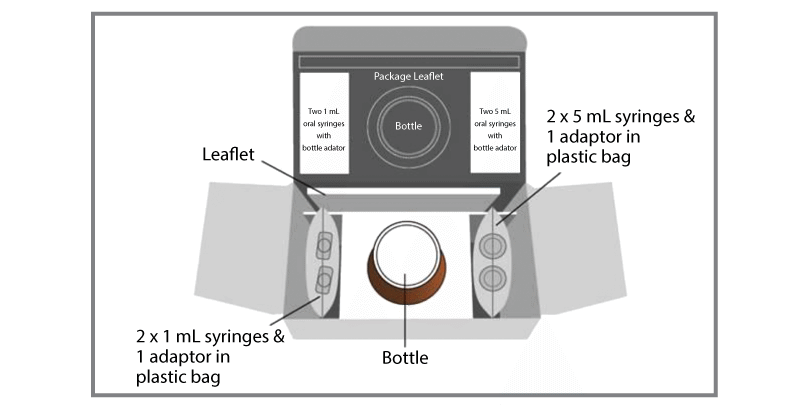
- Open the bag containing the correct oral syringe to measure your dose.
- If your dose is 1 mL (100 mg) or less, you should use the smaller 1 mL syringe.
- If your dose is more than 1 mL (100 mg), you should use the larger 5 mL syringe.
- If your dose is more than 5 mL (500 mg), you will need to use the larger 5 mL syringe more than once. In this case, keep careful track of how many times you have filled the syringe (e.g., by marking off each 5 mL dose, respectively) so that you take the right dose.
It is important that you use the correct oral syringe to measure your dose. Your doctor or pharmacist will let you know which syringe to use depending on the dose that has been prescribed.
Following the directions from the doctor or pharmacist, the bag containing the other syringes and adapter should be discarded from the pack unless your doctor or pharmacist tells you to keep both syringes until your final dose has been reached.
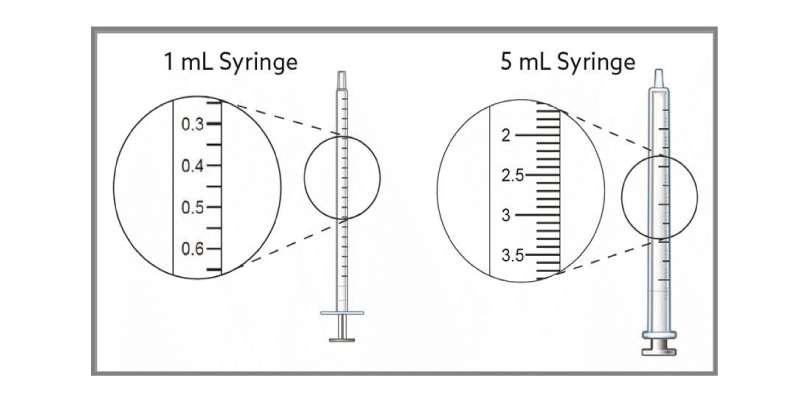
- Remove the child-resistant cap on the bottle by pushing the cap down whilst turning the cap anti-clockwise.
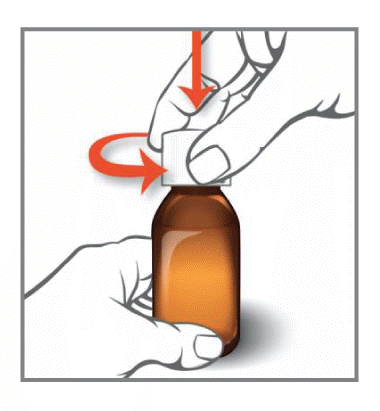
- Push the bottle adaptor firmly into the neck of the bottle, and make sure it is fully inserted. The adaptor could come off and cause choking if it is not fully inserted.
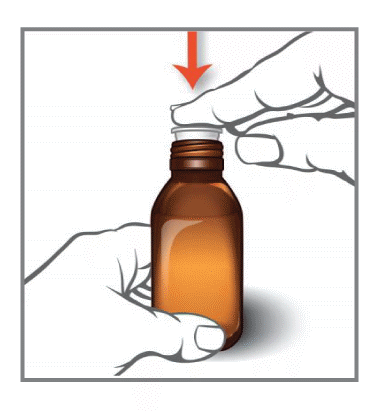
- Insert the tip of the correct oral syringe fully into the bottle adaptor, and with the oral syringe in place, turn the bottle upside down.
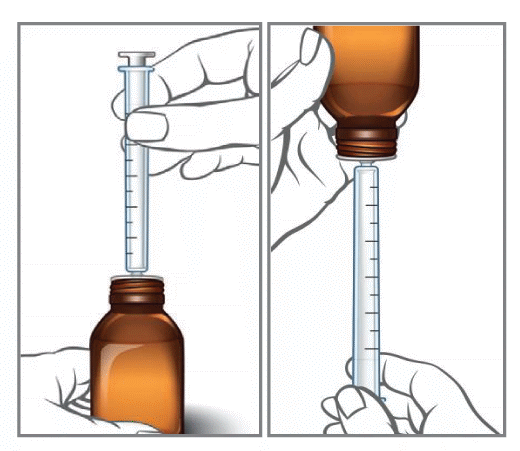
- Slowly pull back the plunger of the syringe, so the volume (number of mL) of solution needed is drawn into the syringe. Line up the end of the plunger with the volume marking required, as shown opposite.
If there is an air bubble in the syringe, push the liquid back into the bottle whilst keeping the bottle upside down, and repeat Step 5 until the bubble has gone.
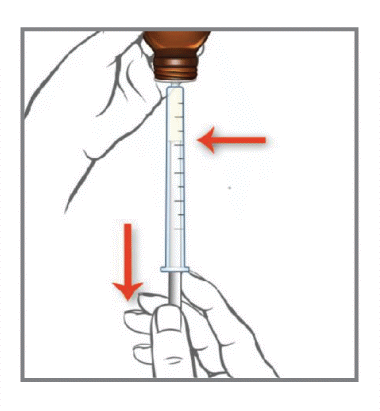
- Turn the bottle the right side up, and carefully remove the oral syringe from the adaptor.
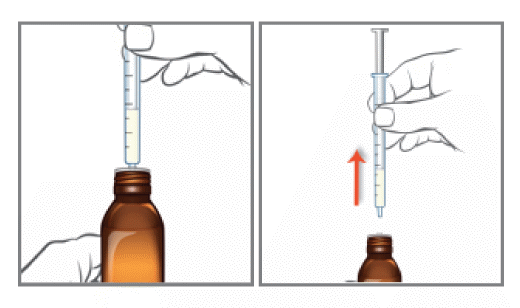
- Place the tip of the oral syringe inside the cheek, and gently push the plunger to release the medicine. Do not push the plunger forcefully or direct the medicine to the back of the mouth or throat.
If the dose is more than 5 mL, repeat Steps 4 to 7 to give the remaining dose using the 5 mL oral syringe.

- Screw the child resistant cap back on the bottle tightly, by turning the cap clockwise – you do not need to remove the bottle adaptor, as the cap will fit over it.
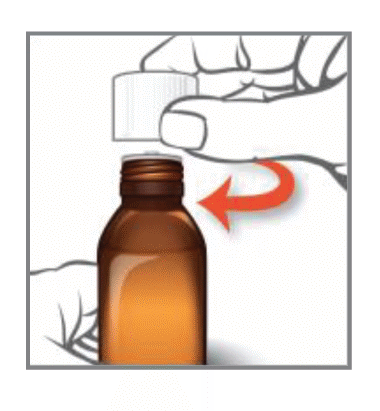
- Fill a cup with warm soapy water and clean the oral syringe by drawing water in and out using the plunger.
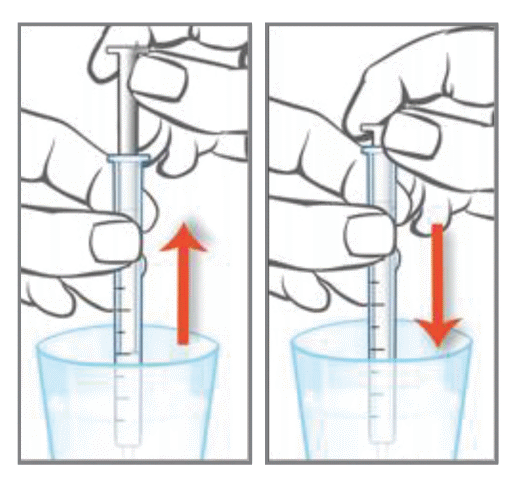
- Remove the plunger from the barrel of the syringe, and rinse both parts under tap water. Do not place the oral syringe in a dishwasher.
Shake off any water from both parts and allow them to dry in the air until the next use. Make sure the oral syringe is completely dry before the next use, or it could make the solution appear cloudy if water gets in the bottle.
If the solution in the bottle has turned cloudy, this doesn’t change how well it works. Continue to use the medicine as normal.
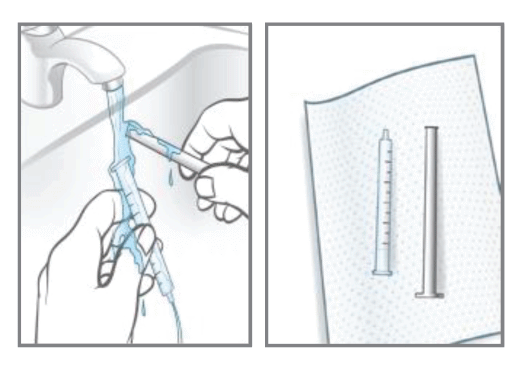
Published by MIMS April 2025




 Compared with placebo, Epidyolex was associated with an increase in the number of drop seizure-free days during the treatment period in each trial, equivalent to an additional 3.3 days per 28 days (10 mg/kg/day) and 2.7 to 4.6 days per 28 days (20 mg/kg/day).
Compared with placebo, Epidyolex was associated with an increase in the number of drop seizure-free days during the treatment period in each trial, equivalent to an additional 3.3 days per 28 days (10 mg/kg/day) and 2.7 to 4.6 days per 28 days (20 mg/kg/day).
 Compared with placebo, Epidyolex was associated with an increase in the number of convulsive seizure-free days during the treatment period in each trial, equivalent to 2.4 days per 28 days (10 mg/kg/day) and 1.3 to 1.4 days per 28 days (20 mg/kg/day).
Compared with placebo, Epidyolex was associated with an increase in the number of convulsive seizure-free days during the treatment period in each trial, equivalent to 2.4 days per 28 days (10 mg/kg/day) and 1.3 to 1.4 days per 28 days (20 mg/kg/day).

